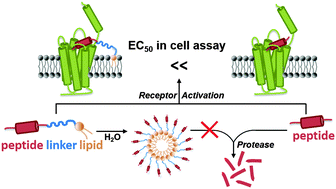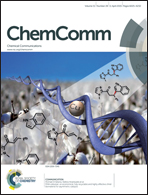Triblock peptide–linker–lipid molecular design improves potency of peptide ligands targeting family B G protein-coupled receptors†
Abstract
Two peptide–linker–lipid constructs were designed and prepared which target the parathyroid hormone 1 receptor, a family B G protein-coupled receptor. Both show increased agonist activity in a cell-based assay. The lipid moiety enables the formation of micelle-like nanostructures, which is shown to hinder proteolytic digestion and is expected to reduce renal clearance.

- This article is part of the themed collection: Identification and Optimization of GPCR Ligands in the 21st Century

 Please wait while we load your content...
Please wait while we load your content...